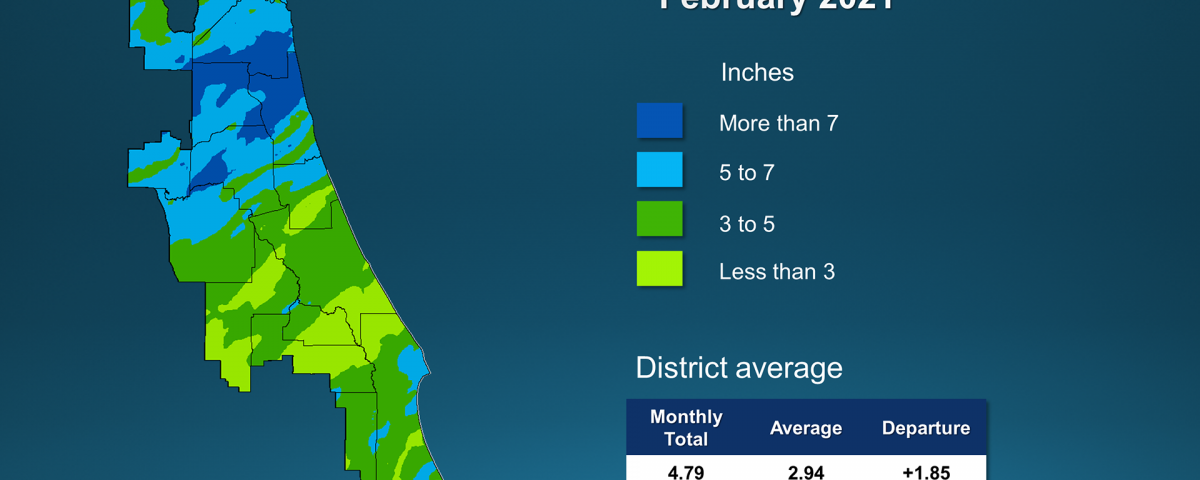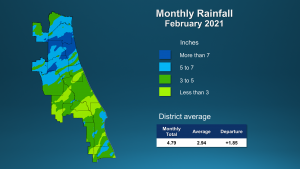Above-average rainfall in February offered relief to winter’s dry weather trend

A map illustrates rainfall conditions in February across the St. Johns River Water Management District.

A map illustrates rainfall conditions in February across the St. Johns River Water Management District.
PALATKA, Fla., March 9, 2021 — February rainfall was above average throughout the St. Johns River Water Management District, although the northern half of the District received considerably more rain than the southern half.
A full report outlining February’s hydrologic conditions was presented at the St. Johns River Water Management District’s Governing Board meeting Tuesday.
Highlights include:
Rainfall
- Districtwide, February rainfall averaged 4.79 inches, which is 1.85 inches above the long-term average for the month.
- Portions of Putnam, Clay, St. Johns and Duval counties received more than 7 inches of rain during February
- Clay County had the highest countywide rainfall total for the month with 7.25 inches.
- Seminole County had the lowest countywide monthly total with 3.1 inches.
- Districtwide, the cumulative total for the past 12 months was 1.3 inches above the long-term average.
Groundwater
- Upper Floridan aquifer conditions (groundwater levels) at the end of February were in the high or normal range across the District.
- Groundwater levels are at the 71st percentile Districtwide. This means that since 1980, aquifer levels have been higher than they are now only about 29 percent of the time.
Surface water flows
- Surface water flow conditions were average for this time of year throughout the District, except for the St. Marys River, which had high flow.
- On March 1, flow in the St. Johns River’s headwaters at the Melbourne station was 245 million gallons per day (mgd), which corresponds to the 67th percentile.
- Flow at the Deland station was 1.9 billion gallons per day (bgd), or the 72nd percentile.
- Flow at the Satsuma station was 3.9 bgd (69th percentile).
- Flow in the Econlockhatchee River near Chuluota was 85 mgd (54th percentile).
- Flows in the Wekiva River near Sanford were 177 mgd (58th percentile).
- Flows in the Ocklawaha River, the largest tributary to the St. Johns River, were in the average range at 633 mgd (64th percentile).
- Flows in the St. Marys River near Macclenny were in the high range at 787 mgd (77th percentile).
Lake levels
- Lake Brooklyn water levels increased 0.5 feet in January to 99.4 feet.
- Lake Weir, at 53 feet, increased 0.2 feet.
- Lake Apopka’s water level did not fluctuate significantly and matched its regulation schedule. Lake Apopka is part of a system with water control structures that are operated by the District to reduce flood impacts, and the lake level is regulated according to a specific schedule.
- Blue Cypress Lake levels increased 0.1 feet to 22.7 feet and remains below its regulation schedule. Blue Cypress Lake is also part of a system with water control structures that are operated by the District.
Spring flows
- The mean monthly flow at Silver Springs decreased to 633 cubic feet per second (cfs), or 409
- At the Blue Spring station in Volusia County, the mean monthly flow decreased to 170 cfs, or 110 mgd, which is in the normal flow range for this time of year
- At Rock Springs, the monthly mean flow decreased 1 cfs to 58 cfs (38 mgd).
- Mean monthly flow at Wekiwa Springs decreased 2 cfs to 69 cfs (45 mgd).
To learn more about rainfall totals and other hydrologic data collected, visit sjrwmd.com.
Visit www.WaterLessFlorida.com for tips to help landscapes thrive while saving water and money. Follow the water conservation conversation at #sjrwmd #waterconservation #savewater.

